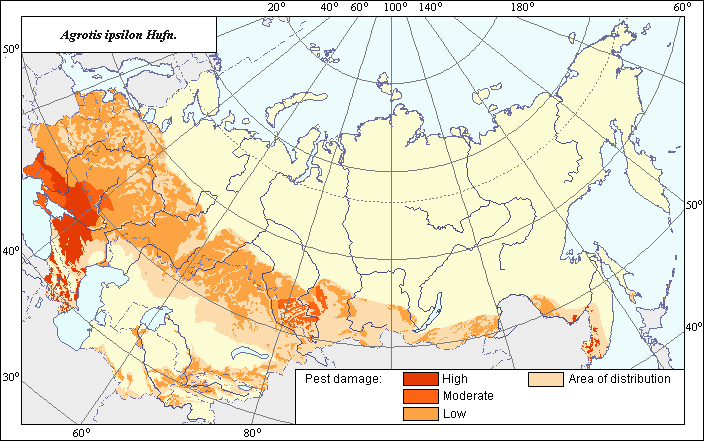Pests
Area of distribution and damage of the Black Cutworm (Agrotis ipsilon Hufn.)
 Object description Download GIS-layers
Object description Download GIS-layers
Authors:
Object biologists - M.A. Chumakov, T.L. Kuznetsova,GIS-specialist - M.I. Saulich.
Date of creation:
21.04.2005.Scale:
1:20 000 000.Accuracy of map:
Map was created based on materials of maps of natural scale 1: 33 000 000.Projection:
"Alber.s Equal Area Conic for the USSR", 9, 1001, 7, 100, 0, 44, 68, 0, 0.Basic contents:
Vector map. Area of species distribution is shown by polygons. Zones of recorded mass outbreak are shown by polygons.Accuracy of classifier:
Three damage zones were defined within the moth area as follows: an area of high damage (number of larvae is permanently within the limits of 3-5 larvae or more per 1 sq. m); an area of moderate damage (number of larvae periodically reaches the economic threshold of 3-5 larvae per 1 sq. m; an area of low damage (number of larvae is less than 3 individuals per 1 sq. m permanently or pest is absent among agricultural crops). This subdivision into damage zones is based on the number of 1st generation larvae that cause the maximum loss of yield among agricultural plantings.Method of map production:
Scientists were given maps with boundaries of Oblasts and arable lands. After reviewing historic literature, species distribution was hand drawn on maps. If data were on the Oblast-level, distribution is on the Oblast level. In some cases, Oblast.s are further refined by boundaries of the Arable Land Map (Koroljeva et al., 2003). Hand drawn maps were scanned, georeferenced and vectorized. The damage and distribution zones were drawn according to the analysis of the following map materials and literature data: Shchegolev et al. (1934), D.yakonov & Kozhanchikov (1949), Druzhelyubova (1964, 1976), Zakharenko et al. (1985), Pospelov (1975, 1989), Sukhareva (1999), Kononenko (2003). The zones of high mountain areas of the Caucasus and the Central Asia were excluded from the area. The species also does not live in sandy and clay deserts. A correction to the pest damage zones was made based on large region distribution according to the map of arable lands (Koroleva et al., 2003).Reference citations:
D.yakonov A.M., Kozhanchikov I.V. 1949. Lepidoptera. In: Pavlovskii E.N., Shtakelberg A.A., eds. Pest Animals of Middle Asia (handbook). Moscow-Leningrad: AN SSSR. 179-198 p. (In Russian)Druzhelyubova T.S. 1964. Turnip Moth and other cutworms. In: Polyakov I.Ya., Chumakov A.E., eds. Proc. VIZR, Issue 22. Leningrad: VIZR. 80-89 p. (In Russian)
Druzhelyubova T.S. 1976. Influence of temperature and light factor on development and behavior of the Black Cutworm geographical populations, Agrotis ypsilon Rott. Entomol. obozr., 55(2): 277-285. (In Russian)
Kononenko V.S. 2003. Noctuidae. In: Ler P.A., ed. Keys to the insects of the Russian Far East. V. 5(4). Trichoptera and Lepidoptera. Vladivostok: Dal.nauka. 688 p. (In Russian)
Koroljeva IE, Vilchevskaya EV, Ruhovich DI. 2003. Digital Arable Land Map. Laboratory of Soil Information of the Dokuchaev Soil Institute, Moscow, Russia [Based on: Yanvareva LF. (ed.), Martynjuk KN., Kisileva NM. 1989. Map of Land Use, Faculty of Geography, Moscow State University, Moscow, Russia.].
Pospelov S.M. 1975. Zoning of territory of Soviet Union by noctuid complexes harming to agricultural crops. In: Berim N.G., ed. Zapiski LSKHI. V. 270. Leningrad-Pushkin: LSKHI. 75-81 p. (In Russian)
Pospelov S.M. 1989. Noctuidae - pests of agricultural crops. Moscow: Agropromizdat. 112 p. (In Russian)
Shchegolev V.N., Znamenskii A.V., Bei-Bienko G.Ya. 1934. Insect pests on field crops. Leningrad-Moscow: Sel.khozgiz. 364 p. (In Russian)
Sukhareva I.L. 1999. Noctuidae. In: Kuznetsov V.I., ed. Insects and mites - agricultural pests. V. 3, Part 2. Lepidoptera. St. Petersburg: Nauka. 332-378 p. (In Russian)
Zakharenko V.A., Chenkin A.F., Cherkasov V.A., Martynenko V.I., Polyakov I.Ya. 1985. Reference book on plant protection. Moscow: Agropromizdat. 415 p. (In Russian)

